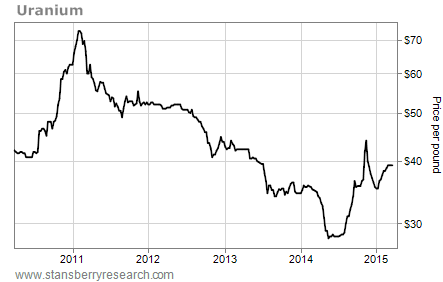If you’ve been investing for a while, you’ve likely heard you can’t make money in the natural resource sector.
It’s true that a lot of investors who deal in the sector are constant losers.
But if you know what you’re doing, you can make serious gains in natural resources.
And setting yourself up to profit starts with one simple rule.
Let me explain…
[ad#Google Adsense 336×280-IA]The resource business is simple at its core… Pull something out of the ground and sell it for more than the cost to extract it.
Of course, that’s often easier said than done.
Especially when you consider one of the big reasons many investors dislike resource investing…
Companies in the natural resource sector have almost no control over the prices of the products they sell.
Compare that with companies in the electronics industry, for example. Tech giant Apple decides the price of its iPhones. Sure, the company has to pay attention to what its competition is doing. It won’t sell many iPhones if it prices them way above other phones. But in general, Apple can decide what price to sell its product for. Because of this, Apple is a “price maker.”
But resource companies must rely on the global benchmark prices to set the prices for their products. These companies are known as “price takers.”
The fact that resource companies don’t set their own prices makes investing in resource companies riskier than investing in companies like Apple. But it doesn’t mean they’re always a bad investment…
As we’ve shown you before, resource stocks can produce gains of 100%, 300%, or even 500%. Investing in just one or two of the right companies can change your life forever.
You just have to remember one simple rule if you’re going to invest in the resource sector: The trend is your friend.
In short, if the price of a natural resource is moving higher, it’s likely to continue moving higher. If the price of a natural resource is falling, it’s likely to continue falling.
As legendary investor Jim Rogers says: “Markets often rise higher than you think is possible, and fall lower than you can possibly imagine.”
Take uranium – the fuel for nuclear power stations – for example.
After Japan’s Fukushima power plant disaster in 2011, no one was interested in uranium. The disaster convinced many people and governments that nuclear power is too dangerous. And the spot price of uranium fell more than 60% from its high in 2011 to its 2014 low.
Now, as I told you last week, the price of uranium is breaking out. It’s up nearly 40% since July 2014.

And the price is likely to keep increasing.
As I told you last week, demand for uranium has been increasing.
Today, there are about seven billion people in the world. Of these seven billion people, around two billion have little to no access to electricity. Many of these people are in emerging markets.
To continue to develop, these markets need sources of low-cost electric power. That’s where nuclear energy comes in. It’s a key component to these markets’ future energy plans. And it will provide a huge source of demand for uranium for decades.
Cameco – one of the leading uranium producers – expects annual consumption of uranium to grow from 155 million pounds to 230 million pounds by 2024. This is a nearly 50% jump.
Rising demand will help support uranium prices.
In short, the trend for uranium prices is up. That means uranium producers like Cameco – and their share prices – are likely to benefit.
When it comes to investing in natural resources, it pays to size up the trend. You don’t want to stay long during big downtrends… and you don’t want to short during big uptrends. In the case of uranium, it has suffered a downtrend over the past few years… but it’s likely ending. That makes companies like Cameco a good buy right now.
Good investing,
Brian Weepie
[ad#stansberry-ps]
Source: Growth Stock Wire
